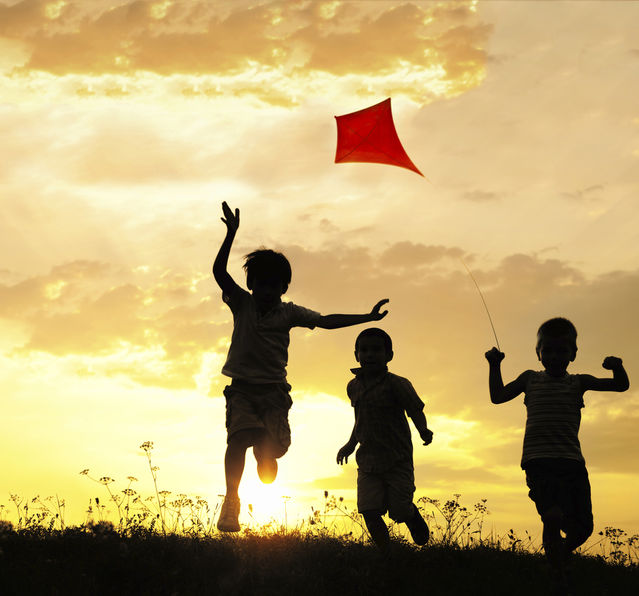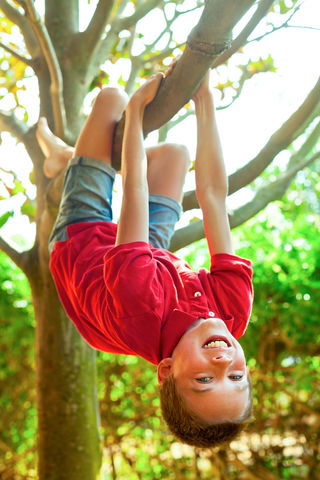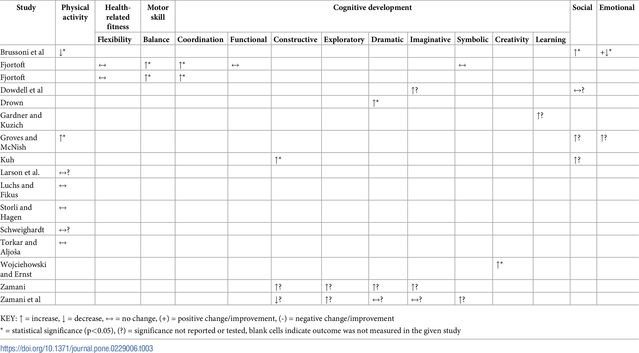Play
Playing Freely in Nature May Be Really Good for Kids
Unstructured "nature play" benefits early childhood development in many ways.
Posted February 16, 2020 Reviewed by Devon Frye

A new systematic review reports that unstructured free play in natural environments positively impacts children’s cognitive development, along with influencing outcomes related to physical activity, fitness levels, motor skills, social skills, emotional well-being, and creativity.
This first-of-its-kind systematic review explores the impact of "unstructured nature play" on health and early childhood development between the ages of 2-12 years. The findings (Dankiw et al., 2020) were published on February 13 in the journal PLOS ONE.
"To our knowledge, this is the first rigorously conducted systematic review that comprehensively and transparently adds to the current evidence base for nature play," the authors write.
You may be asking: "What exactly is nature play?" Unfortunately, there still isn't a universal, clear-cut definition of the term nature play.
For this systematic review, the umbrella term "nature play" was used to describe "unstructured, free play within nature (forest, green spaces, outdoors, gardens) and included natural elements (highly vegetated, rocks, mud, sand, gardens, forests, and ponds or water)."
Although nature-based play spaces for children that include plants, trees, and rocks are growing in popularity, there is relatively little empirical evidence to support anecdotal claims that playing freely in nature is beneficial for children's overall health and development.
Out of 2,927 articles originally considered for this systematic review, only 16 eligible peer-reviewed studies met this systematic review's rigorous inclusion criteria.

"Studies were excluded if the exposure or intervention involved structured activities such as sport and other organized activities (such as but not limited to outdoor education programs with structured activities, orienteering)," the authors write. "The rationale for excluding outdoor education programs was decided upon after an extensive review of the literature (undertaken prior to the conduct of this systematic review), which highlighted that educational programs commonly follow structured activities in nature and follow a curriculum."
For this systematic review of the impact nature play has on health and early childhood development, Kylie Dankiw and colleagues at the University of South Australia focused on 16 different 21st-century studies that were published from 2001-2017.
Dankiw et al. strived for the highest degree of scientific rigor by pre-registering the review protocol with PROSPERO (international prospective of registered systematic reviews) in advance and following PRISMA (transparent reporting of systematic reviews and meta-analyses) guidelines during their analysis.
"Our research is the first to rigorously, transparently, and systematically review the body of work on nature play and show the impact it has on children's development. We're pleased to say that the findings indicate a positive connection between nature play and children's development," Dankiw said in a news release. "For early childhood educators, health practitioners, policymakers, and playspace designers, this is valuable information that may influence urban play environments and re-green cityscapes."
What Is an Everyday Way to Describe Nature Play?
"Nature play is all about playing freely with and in nature. It's about making mud pies, creating stick forts, having an outdoor adventure, and getting dirty," Dankiw said.
"By playing in nature, children can build their physical capabilities—[such as] balance, fitness, and strength. And, as they play with others, they learn valuable negotiation skills, concepts of sharing and friendships, which may contribute to healthy emotional and social resilience," she added. "These are all things that children love to do, but unfortunately, as society has become more sedentary, risk-averse, and time-poor, fewer children have these opportunities."
The table below lays out 16 different studies linked to six broad categories (e.g., physical activity, health-related fitness, motor skill, cognitive development, social, emotional) with multiple subcategories (e.g., flexibility, balance, coordination, creativity, learning, etc.) relating to unstructured nature play and early childhood development outcomes.

As you can see in the diagram above, the 16 studies in this systematic review includes:
- One study about creativity
- Two studies on emotional outcomes
- Two studies reporting improved health-related fitness (flexibility) and better motor skill (balance and coordination) outcomes
- Four studies relating to social outcomes
- Five studies reporting positive outcomes related to cognitive development
- Seven studies relating to physical activity outcomes
(See the references box below for more details on the 16 studies included in this systematic review.)
Despite some variability in the outcome measurements, taken together, these findings suggest that nature play has positive impacts across a wide range of outcomes relating to children's health and development.
That said, the underlying research included in this review has some significant limitations. Dankiw and co-authors openly acknowledge:
"The current body of evidence has many methodological concerns relating to sample bias, reporting of results, and the reliability and validity of outcome measures. Therefore, due to these methodological concerns of the evidence base, the findings of this review and recommendations should be interpreted with caution."
The University of South Australia researchers recommend that future studies on nature play should address the need for standardized methods used to observe and characterize children's play behavior. Dankiw et al. also drive home the importance of people around the globe agreeing upon a universal definition for nature play and nature play environments:
"There remains ambiguity in the literature around what constitutes a nature play environment—therefore, a universal definition should be developed to inform future research. Such research could bring together key stakeholders (educators, consumers, health practitioners, policymakers, playspace designers, etc.) to develop a universally agreed definition of nature play through consensus-based research (such as Delphi, nominal group technique). A universal definition would also afford the development of guidelines to assist policymakers, educators and practitioners to design, implement, and evaluate nature play spaces and experiences for children."
Hopefully, this systematic review (and the references listed below) will serve as a valuable resource and inspiration for the creation of more optimal playspaces and an uptick in unstructured free play in natural environments for today's kids (ages 2-12) and younger generations to come.
References
Kylie A. Dankiw, Margarita D. Tsiros, Katherine L. Baldock, Saravana Kumar. “The Impacts of Unstructured Nature Play on Health in Early Childhood Development: A Systematic Review.” PLOS ONE (First published: February 13, 2020) DOI: 10.1371/journal.pone.0229006
Sixteen studies included in the systematic review by Dankiw et al. (2020):
1. "Landscapes for Play: Effects of an Intervention to Promote Nature-Based Risky Play in Early Childhood Centres" (Brussoni et al., 2017) DOI: 10.1016/j.jenvp.2017.11.001
2. "Nature and Its Influence on Children's Outdoor Play." (Dowdell et al., 2011) DOI: 10.1007/BF03400925
3. "Dramatic Play Affordances of Natural and Manufactured Outdoor Settings for Preschool-Aged Children." (Drown & Christensen, 2014) DOI: 10.7721/chilyoutenvi.24.2.0053
4. "The Natural Environment as a Playground for Children: The Impact of Outdoor Play Activities in Pre-Primary School Children. "(Fjortoft , 2001) DOI: 10.1023/A:1012576913074
5. "Landscape as Playscape: The Effects of Natural Environments on Children's Play and Motor Development. Children, Youth and Environments." (Fjortoft, 2004) DOI: 10.7721/chilyoutenvi.14.2.0021
6. "Green Writing: The Influence of Natural Spaces on Primary Students’ Poetic Writing in the UK and Australia." (Gardner & Kuzich, 2018) DOI: 10.1080/0305764X.2017.1337720
7. "Natural Play: Making a Difference to Children’s Learning and Wellbeing." (Groves & McNish, 2011) Link to PDF
8. "The Impact of a Natural Playscape Installation on Young Children's Play Behaviors." (Kuh et al., 2013) DOI: 10.7721/chilyoutenvi.23.2.0049
9. "The Role of the Physical Environment in Promoting Physical Activity in Children Across Different Group Compositions." (Larson et al, 2014) DOI: 10.1177%2F0145445514543466
10. "Differently Designed Playgrounds and Preschooler's Physical Activity play. Early Child Development and Care." (Luchs & Fikus, 2018) DOI: 10.1080/03004430.2016.1213726
11. "Affordances in Outdoor Environments and Children's Physically Active Play in Pre-School." (Storli & Hagen, 2010) DOI: 10.1080/1350293X.2010.525923
12. "Natural play, Healthy Play: Environmental Determinants of Young Children's Outdoor Physical Activity." (Schweighardt et al, 2016) DOI: 10.1016/j.pbj.2017.03.003
13. "Children's Play and Physical Activity in Traditional and Forest (Natural) Playgrounds." (Torkar, 2017) DOI: 10.12973/ijem.3.1.31
14. "Creative by Nature: Investigating the Impact of Nature Preschools on Young Children's Creative Thinking." (Wojciehowski & Ernst, 2013) Link to PDF
15. "Affordance of Cognitive Play by Natural and Manufactured Elements and Settings in Preschool Outdoor Learning Environments." (Zamani, 2013) Link to PDF
16. "The Cognitive Play Behaviour Affordances of Natural and Manufactured Elements Within Outdoor Preschool Settings." (Zamani & Moore, 2013) Link to PDF




